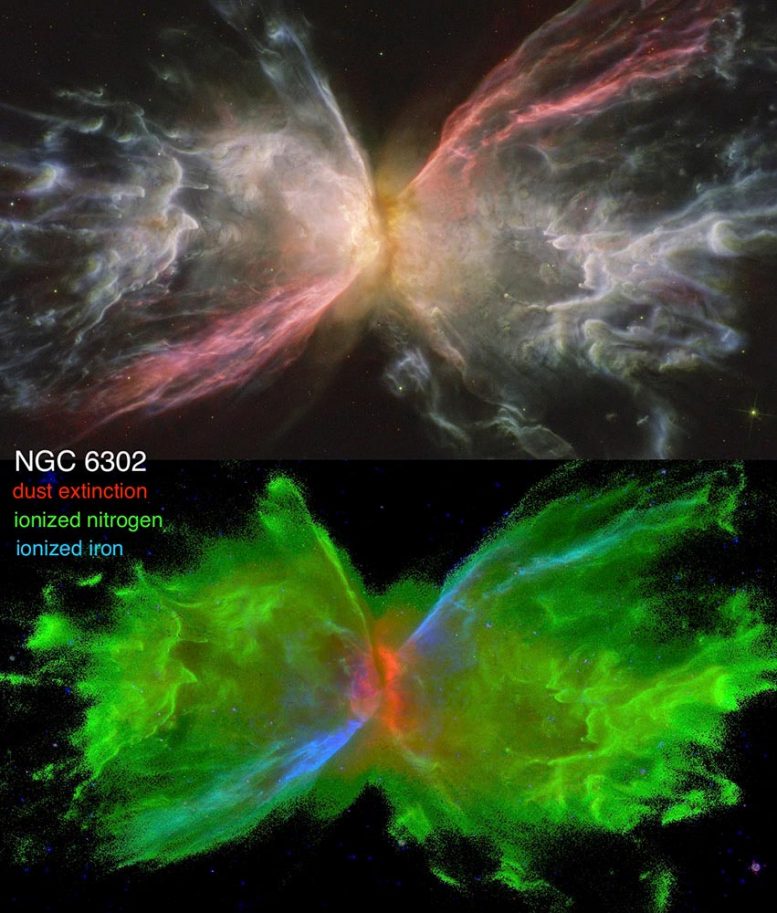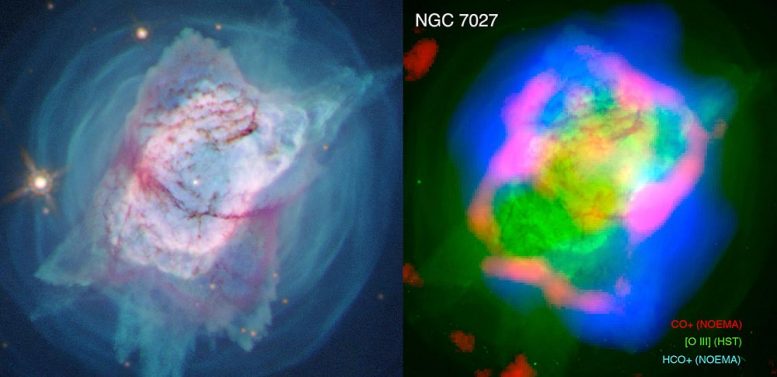
Anatomy of Planetary Nebulae using the Hubble Space Telescope
On the left is an image of the Jewel Nebula (NGC 7027) captured by the Hubble Space Telescope in 2019 and released in 2020. Further analysis by researchers has produced an RGB image on the right, which shows extinction due to dust, as inferred from the relative strength of the two emission lines. Hydrogen, as red; Emission from sulfur, with respect to hydrogen, as green; The emissions from iron are blue. Credit: STScI, Alyssa Pagan
Images of two iconic planetary nebulae by Hubble Space Telescope They reveal new information about how to develop their dramatic features. Researchers from Rochester Institute of Technology and the Green Bank Observatory presented new findings about the Butterfly Nebula (NGC 6302) and the Jewel Nebula (NGC 7027) at the 237th meeting of the American Astronomical Society on Friday January 15, 2021.
Hubble’s Wide Field Camera 3 detected nebulae in 2019 and early 2020 using its full capabilities, and astronomers participating in the project are using images of the emission line from near ultraviolet to near infrared to learn more about their properties. These studies were the first of their kind in the field of panchromatic imaging designed to understand the formation process and test models for the formation of a planetary nebula with two stars.
“We’re doing their anatomy,” said Joel Kastner, a professor at the Chester F. Carlson Center for Imaging Sciences and the RIT School of Physics and Astronomy. “We are able to see the effect of the dying central star in how its ejected material shreds and rips. We now see where the ionizing gas dominates the material that the central star has thrown away, where it is dominated by cooler dust, and even how the hot gas ionises, whether due to the star’s ultraviolet rays. Or because of the collisions caused by the present, fast winds. “

Above is an image of the Butterfly Nebula (NGC 6302) captured by the Hubble Space Telescope in 2019 and released in 2020. Further analysis by the researchers produced an RGB image below, which shows extinction due to dust, as inferred from relativity. Power of hydrogen emission linear, as red; Emissions from nitrogen, with respect to hydrogen, as green; The emissions from iron are blue. Credit: STScI, APOD / J. Schmidt. J. Kastner (RIT) et al.
Analysis of the new HST images of the Butterfly Nebula confirms that the nebula only came out about 2,000 years ago – an eye link according to astronomy standards – and demonstrated that the S-shaped iron emission helps give it smaller “wings” of gas, Castner said. Surprisingly, they discovered that while astronomers previously believed they had located the nebula’s central star, this previously identified star is not actually associated with the nebula, but rather is much closer to Earth than the Butterfly Nebula. Castner said he hopes future studies will be with James Webb Space Telescope It can help locate the true dying star in the core of a nebula.
The team’s ongoing analysis of Jewel Bug Nebula is built on 25 years of measurements dating back to early Hubble photography. Paula Moraga Baez, PhD in astrophysics and technology. A student in DeKalb, Illinois, described the nebula as “remarkable for the unusual juxtaposition of symmetric, axial, symmetric, and symmetric (dipole) point structures.” “The nebula also retains large masses of molecular gas and dust even though it harbors a hot central star and exhibits high excitation states,” Moraga noted.

The RGB image on the right reveals the spatial separation of CO + (red) and HCO + (blue) molecules, denoting the UV and X-ray processes, respectively. The much deeper visual image of [O III] (Green) provides juxtaposition of the ionized atomic structure and that of radio molecular observations. Credit: STScI, Alisa Pagan; J. Bublitz (NRAO / GBO) et al.
Jesse Publitz 20 PhD. (Astrophysics Science and Technology), now a postdoctoral researcher at the Greenbank Observatory, expanded the team’s analysis of NGC 7027 with radio images from the Northern Millimeter Extended Array (NOEMA), from which the molecular tracker determined how the ultraviolet light continued to collide X-rays change the chemistry of the nebula. The combined observations from telescopes of other wavelengths, such as Hubble, and the bright particles CO + and HCO + from NOEMA indicate how different regions of NGC 7027 are affected by the high-energy radiation from its central star.
“We are very excited about these results,” Bublitz said. “We were hoping to find a structure that clearly shows that CO2 + and HCO + are spatially or completely identical in distinct regions, which we did. This is the first map of NGC 7027, or any planetary nebula, in the CO + molecule, and the map of dioxide Carbon CO + second only to any astronomical source. “
Meeting: The 237th Meeting of the American Astronomical Society
In addition to Kastner, Moraga and Bublitz, HST photography co-research team includes Rodolfo Montez Jr ’10 PhD. (Astrophysics Science and Technology) from Harvard Smithsonian University CfA; Bruce Palick from University of Washington; So is Adam Frank and Eric Blackman from the University of Rochester. Bublitz’s international team of collaborators on radio-molecular imaging for NGC 7027 includes Kastner and Montez Jr. And astrophysicists from Spain, France and Brazil.

“Analist. Schepper. Zombiefanaat. Fervente reisjunkie. Popcultuurexpert. Alcoholfan.”
